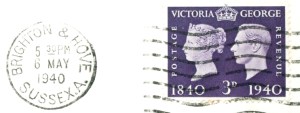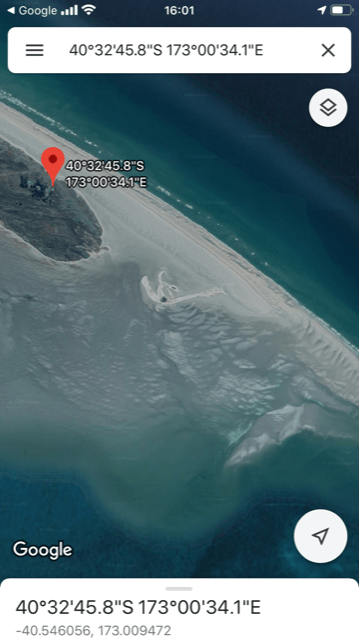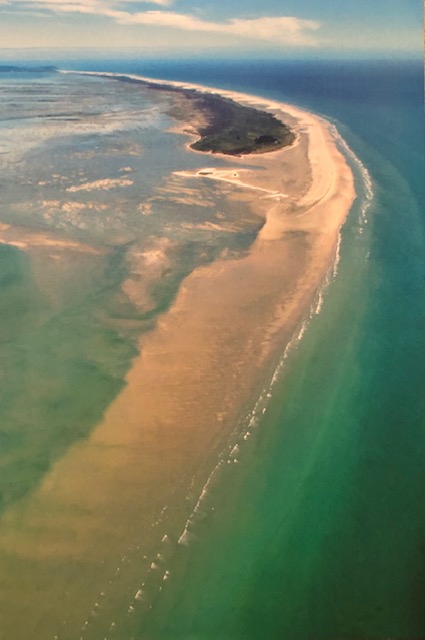
A glass Kiwi by Flame Daisy, a Nelson artist
Adrift on Tasman Bay! Despite the Captain wanting the boats to stay together as far as possible, the lifeboat, cutter and the Captain’s Gig carrying the 26 passengers and 24 crew drifted independently away from The Queen Bee, stranded fast on the sand and taking on water. There were few oars, no sails and little provisions. (See PC 169)
The lifeboat carrying a Mrs Gibbs, some of her 8 children, and other passengers and crew, slipped to the east of Separation Point and south into the estuary of the Awaroa River, where it beached a day and a half later.

Awaroa River entrance

Today Awaroa is part of the Able Tasman National Park, an area of immense beauty and wilderness, attracting walkers and bird watchers, those wanting quiet and those wanting a chance to unwind. Abel Tasman, a Dutch explorer, had charted both North and South Island in 1642. Today his name also lives on in the Tasman Sea which separates Australia and New Zealand and in Tasmania, originally named Van Diemen’s Land.
There are no roads through the park and access is on foot or by ‘sea-shuttle’, out of Kaiteriteri. (I had a real problem pronouncing this little resort, as initially I took the first four letters …. and then had nowhere to go! As soon as I thought ‘Kai…..’ it was easy as in Kai … teri…teri. Funny life huh!) The trip up to Awaroa took some 80 minutes; we stopped to let people on and off, we detoured to look at seals and rock formations ……

… and the colour of the cool water just made you feel good to be alive. We stayed in the Awaroa Lodge, tucked in the bush a few hundred metres from the beach.

East of Awaroa across Tasman Bay, D’Urville Island forms the western edge of the Marlborough Sounds, an area of some 4000 km² of islands, sounds and peninsulas. The island was named after the French explorer Cesar Dumont D’Urville, who had sailed through in his corvette Astrolabe in 1827. Whilst the Captain’s gig beached on its northern tip, 35 kms down on its southern tip, the cutter carrying Eva and her two sisters ran into Te Puna Bay.

Te Puna Bay
Here they stayed until the following day when they rowed up the treacherous channel between the mainland and D’Urville Island, through the narrows of French Pass, where the sea rushes through at around 8 knots in a series of violent eddies and whirlpools, and around the corner into Elmslie Bay.

The Narrows of French Pass

D’Urville Island and the narrows of French Pass

Elmslie Bay
The first settler to put down roots on this remote headland had been an Arthur Elmslie in 1857. Twenty years later the overloaded, leaking cutter carrying twenty two survivors from the Queen Bee arrived, after a traumatic 55 hour passage, the men, women, children and one ten day old baby, often up to their waists in water and continually baling to keep the boat afloat.

We walked on that pebbly beach …….. and I imagined the sheer relief as the crunch of the keel of the cutter carrying Eva and the others announced their deliverance. Hours later the ship Aurora, out of Nelson, anchored offshore, the survivors taken on board and eventually, after awaiting a change in the tide, the ship returned to a huge welcome in the town.

The second pier (circa 1950) at Elmslie Bay replaced the 1907 one
I am in awe of nature and the landscape and out on the road to and from French Pass, I can’t not stop for another photograph, another look, another ‘soak-up-the-scenery’. Looking east from the road towards Hallam Cove and the little community of Cissy Bay, the vegetation is draped across the hills like gathered velvet, or like the facial skin folds of a Pug puppy.

It’s breathtaking, it’s 100% pure New Zealand …… and around every bend there was another photo opportunity! Celina looked resigned! It’s 60 kilometres from the start of Rai Valley to this isolated community and the road took four years to build, scraped from the hillside by the bulldozer of the Blake Brothers who won contract after contract to finally complete it in 1957.

The road snaking along the hills
Eva’s traumatic experience drew us to French Pass; without that we probably would never have gone (Note 1). Fifty people live here, but the nearest provisions are effectively in Nelson, 90 minutes away. We were self-catering, so we had to take everything we needed for three nights ….. but we didn’t count on having no electricity for 20 hours …… and that meant no water, as in rural communities water is pumped; for while we were there in December last year South Island suffered some torrential rain and long-lasting thunderstorms. Further south in Timaru someone recorded 250 mm of rain in 24 hours!

Thunderstorms over D’Urville Island
We had left Collingwood, right up on the north-west corner of South Island, to start our Farewell Spit Tour.

The Collingwood Old Courthouse Café – a good place for lunch
We had stayed at ‘Adrift at Golden Bay’, near Takaka (another interesting pronunciation. My instinct was to accent the ‘k’s …. as in TaKaKa, but was corrected by the girl behind the bar at The Mussel Inn who said the locals pronounce it Taaaakaka.). Run by a lovely chap originally from Bolton, Lancashire, it was a wonderful oasis of calm with its own private beach.

The view from our chalet across the immaculate gardens to the sea.
Then around the crescent of Tasman Bay, through Nelson, and out to French Pass, along that long dirt road. Everywhere we went we encountered friendly and curious Kiwis, interested in what we were doing. If it hadn’t been for that old yellowing front page of The Nelson Evening Mail from 11th August 1877, we might never have known about the Queen Bee and never have gone, but by God we are glad we did. One hundred percent pure New Zealand you might say?
Richard 23rd January 2020
PS Before flying home, from Nelson we flew up to Auckland for the weekend and caught up with distant relatives (the connection is the great great grandfather!!) who have become good friends.
PPS When thinking about this trip, I went to Google Maps, zoomed in on Nelson on South Island, found a travel agent (worldtravellers.co.nz) and sent them an email. If anyone knew about the local area, they would. The whole trip, including international flights and our Singapore stay, was organised by email through them. When we were on the ground, having a local contact was invaluable. Highly recommended!!
Note 1 In 2015 we drove a similar journey to Eagle in Alaska. Seventy miles down the Taylor Highway, Eagle on the Yukon River is another isolated community at the end of a long dirt road! George Nation, whom Eva had married in Dunedin in 1884, managed a gold mining operation there in 1901 (See PC 44 & 45).















